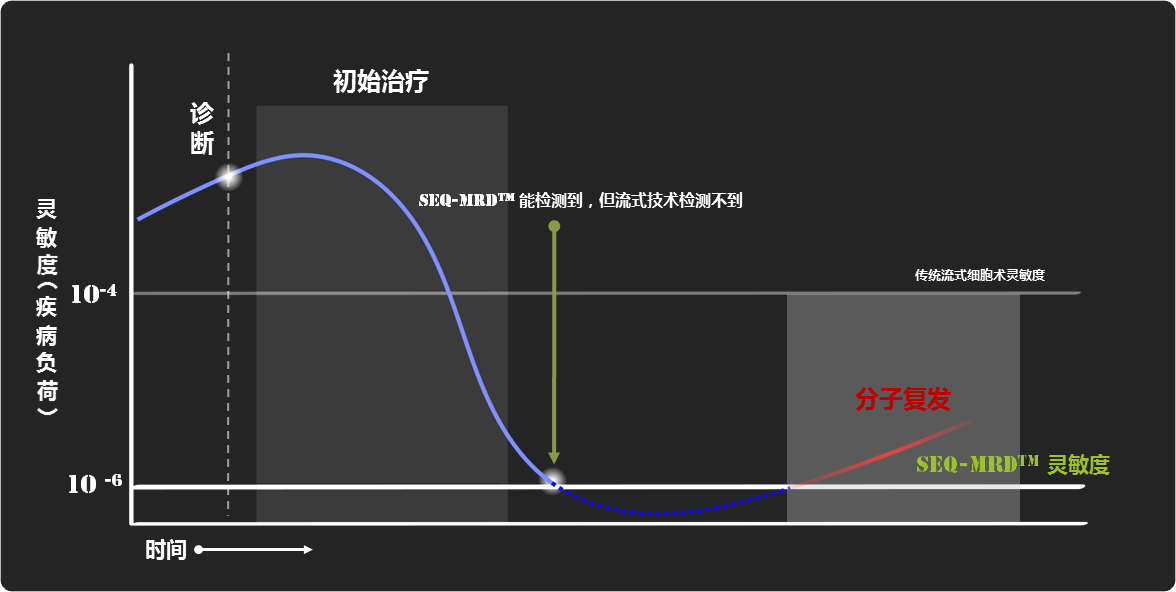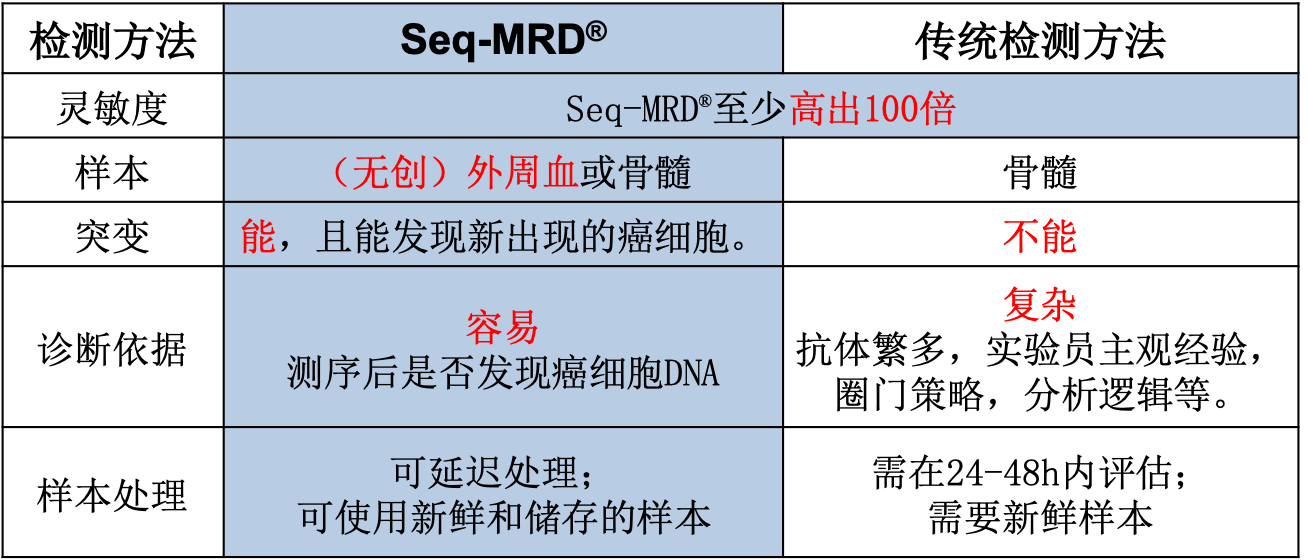Seq-MRD®
让癌细胞无处遁形
基于二代测序的筛查方法可以发现目前传统标准方法未能检测的淋巴癌/白血病/骨髓瘤克隆。
------欧洲血液学协会(EHA)第18届代表大会摘要S537
------欧洲血液学协会(EHA)第18届代表大会摘要S537
Wendy Stock, M.D
芝加哥大学癌症综合治疗中心白血病教授
超高的MRD检测灵敏度
微小残留病 (Minimal Residual Disease, MRD) 是指白血病/淋巴瘤/骨髓瘤患者经治疗缓解后,体内仍残留少量癌细胞的状态,最终可能会引起疾病复发。因残留的癌细胞数量较少,不易察觉,因此需要更准确和灵敏地方法才能检测得到。
Seq-MRD®是基于二代高通量测序技术,通过对患者进行T细胞受体(TCR)或B细胞受体(BCR)高通量测序,从而高准确和高灵敏地对白血病/淋巴瘤/骨髓瘤患者体内微小残留病(MRD)进行检测服务的产品。能帮助临床医生预测长期疗效、评估治疗效果、监测缓解状态以及检测早期复发。
利用二代测序技术检测MRD的重要性
围绕微小残留病(MRD)检测的争议之一是其评估的最佳技术。 纽约纪念斯隆凯特琳癌症中心的Landgren教授在美国血液学会(ASH)2017年年会中接受采访,就MRD评估的最佳方法提出了他的看法。 强调了二代测序检测MRD的很多优势,比如可重复性和灵敏度均高于传统检测方法等。

相比传统的MRD检测方法,Seq-MRD®检测仅需五分之一的样本量便可达到100倍的灵敏度。Seq-MRD®能在100万个健康细胞中检测出隐藏的一个癌细胞。传统MRD检测一般用骨髓样本,但因这种检测技术灵敏度受限,无法在肿瘤负荷较低的血液样中检测到MRD,而Seq-MRD®检测使用骨髓和外周血样本均可,使用血液样本可以达到无创检测。
Seq-MRD®的优势

使用Seq-MRD®作为您MRD监控手段
二代测序方法作为新兴的MRD检测方法,也已受到国内外专家认可并推荐。2017年版国际临床实践指南(NCCN)、2016年版《中国成人急性淋巴细胞白血病诊断与治疗指南》和2017年版《中国多发性骨髓瘤诊治指南》均推荐高通量测序(NGS)作为MRD检测方法。
参考文献:
-
Predictive value of next-generation sequencing-based minimal residual disease after CAR-T cell therapy. Bone Marrow Transplant 57, 1350–1353, 2022
-
Referenced with permission from the NCCN Clinical Practice Guidelines in Oncology [NCCN Guidelines®] for Multiple Myeloma V.3.2017. ©National Comprehensive Cancer Network, Inc. 2017. All rights reserved. Accessed May 11, 2017
-
Deep-sequencing approach for minimal residual disease detection in acute lymphoblastic leukemia. Blood. 2012;120:5173-5180.
-
Detection of Minimal Residual Disease Using Next Generation Sequencing for Antigen Receptor Gene Rearrangements in Acute Lymphoblastic Leukemia. Clinical Lymphoma, Myeloma & Leukemia June 2015, 105
-
High-Throughput Sequencing Detects Minimal Residual Disease in Acute T Lymphoblastic Leukemia. 16 May 2012 Vol 4 Issue 134 134ra63
-
Immunoglobulin and T cell receptor gene high-throughput sequencing quantifies minimal residual disease in acute lymphoblastic leukemia and predicts post- transplantation relapse and survival. Biol Blood Marrow Transplant. 2014;20:1307-1313.
Next-generation sequencing and real-time quantitative PCR for minimal residual disease detection in B-cell disorders. Leukemia. 2014;28:1299-1307.
- High-throughput sequencing detects minimal residual disease in acute T lymphoblastic leukemia. Sci Transl Med. 2012;4:134ra163.
- Minimal residual disease quantification using consensus primers and high-throughput IGH sequencing predicts post-transplant relapse in chronic lymphocytic leukemia. Leukemia. 2013;27:1659-1665.
- Minimal residual disease in acute myeloid leukaemia. Nat Reviews Clin Oncol. 2013;10:460-471.
- The predictive strength of next-generation sequencing MRD detection for relapse compared with current methods in childhood ALL. BLOOD, 20 AUGUST 2015 x VOLUME 126, NUMBER 8
- Minimal residual disease diagnostics in acute lymphoblastic leukemia: need for sensitive, fast, and standardized technologies. Blood. 2015;125(26):3996-4009.
- Fast multiclonal clusterization of V(D)J recombinations from high-throughput sequencing. BMC Genomics. 2014; 15:409.
- Minimal Residual Disease in Acute Myeloid Leukemia—Current Status and Future Perspectives Current Hematologic Malignancy Reports, 2015, Page 1
